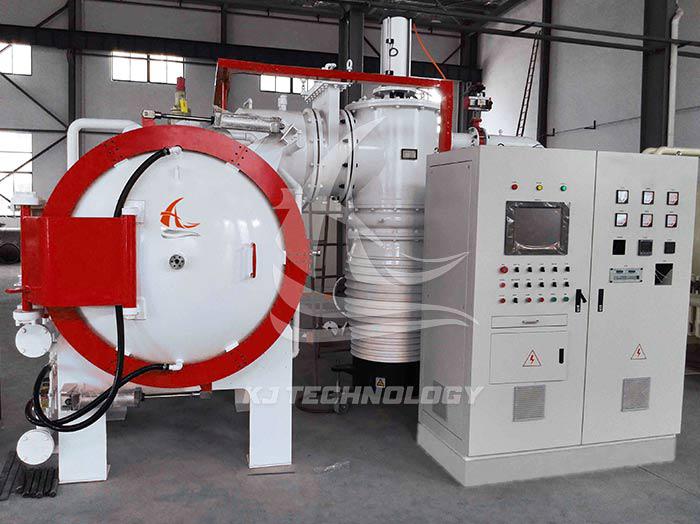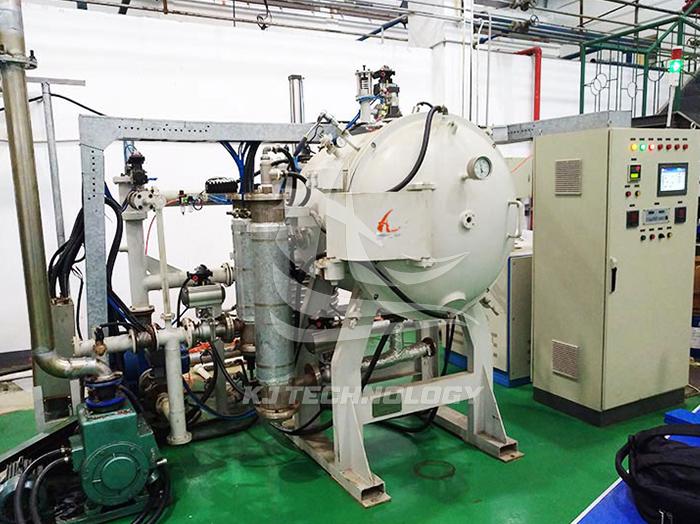Working principle of vacuum powder sintering furnace
 09-09-2025 Author: KJ technology
09-09-2025 Author: KJ technology
The working principle of the vacuum powder sintering furnace is based on the synergistic effect of vacuum environment and high-temperature heating. By eliminating oxygen, controlling the atmosphere, and precise temperature control, the densification and performance optimization of powder materials are achieved. The following is a detailed step-by-step explanation of its working principle:
1. Core objective
Under vacuum or protective atmosphere, the powder material undergoes the following changes by high-temperature heating:
Degassing: Discharging adsorbed gases and volatile impurities between powder particles.
Densification: The bonding between particles is achieved through diffusion, flow, or plastic deformation, reducing porosity.
Phase transition and reaction: promote the transformation of the internal organizational structure or chemical reaction of materials (such as solid-state reaction, liquid-phase sintering).
2. Step by step analysis of working principle
a. Vacuum pumping stage
Purpose: To create a low oxygen or anaerobic environment, prevent material oxidation, and promote gas release.
Process:
After closing the furnace door and sealing it, start the vacuum pump system (usually a combination of mechanical pump and diffusion pump).
The mechanical pump initially lowers the vacuum (to about 10 ⁻¹ Pa), and then the diffusion pump starts to increase the vacuum level to a higher level (up to 10 ⁻³~10 ⁻⁴ Pa).
The vacuum gauge monitors the pressure inside the furnace in real-time to ensure that it meets the process requirements.
Key role:
Avoid oxidation of metal powders (such as copper, iron, etc.) at high temperatures.
Reduce gas partial pressure and promote the volatilization of adsorbed gases (such as H ₂ O, CO ₂) in the powder.
b. Heating stage
Purpose: To provide energy to reach the sintering temperature of powder particles and trigger physical and chemical changes.
Process:
The heating system is activated to uniformly heat the furnace through resistance wires, induction coils, or graphite heaters.
The temperature controller adjusts the power according to the preset process curve (heating rate, holding time, cooling rate).
Thermocouples or infrared thermometers provide real-time feedback on temperature data to ensure temperature accuracy (usually ± 1-5 ℃).
Key role:
Activate atomic diffusion on the surface of particles to promote neck growth (interparticle binding points).
In liquid-phase sintering, low melting point components are melted to form a liquid phase, accelerating densification.
c. Control of protective atmosphere (optional)
Purpose: To supplement protective gases in specific processes to prevent material volatilization or promote reactions.
Process:
After the vacuum degree reaches the required level, high-purity inert gases (such as Ar, N ₂) or reducing gases (such as H ₂) can be filled.
Accurately control the gas flow rate through a quality flowmeter to maintain stable gas pressure inside the furnace.
Key role:
Prevent the reaction between materials and residual oxygen at high temperatures (such as strict oxygen free sintering of titanium alloys).
Reduce metal oxides (such as WO3 in tungsten powder) in a hydrogen atmosphere.
d. Sintering stage
Purpose: To achieve theoretical density or specific properties of materials through long-term insulation.
Process:
Powder particles undergo the following mechanisms at high temperatures:
Solid state sintering: Atomic diffusion on the surface of particles forms necks and reduces pores.
Liquid phase sintering: The liquid phase fills the pores and promotes particle rearrangement through capillary action.
Activated sintering: Adding activators (such as Ni, Co) to lower the sintering temperature and accelerate diffusion.
The insulation time is adjusted according to the material type and thickness (usually several hours to tens of hours).
Key role:
Eliminate internal defects and improve mechanical properties such as material strength and hardness.
Control grain growth to avoid performance degradation caused by excessive coarsening.
e. Cooling stage
Purpose: To safely reduce temperature and fix material structure.
Process:
After stopping heating, the furnace should be naturally cooled or forced air-cooled/water-cooled.
Maintain a vacuum or protective atmosphere during high temperature stages to prevent material oxidation or moisture absorption.
After the temperature drops to a safe range, fill in air and open the furnace door to take out the sample.
Key role:
Avoid rapid cooling that may cause thermal stress cracking (such as in ceramic materials).
Retain specific phase structures (such as martensitic transformation requiring controlled cooling rate).
3. Key technological advantages
High purity: Vacuum environment eliminates gas pollution, suitable for high-purity requirements such as semiconductors and optical materials.
Low energy consumption: The insulation system reduces heat loss and has high heating efficiency.
Process flexibility: It can be combined with auxiliary technologies such as hot pressing and hot isostatic pressing to further optimize material properties.
Pollution free: The closed system avoids harmful gas emissions and meets environmental protection requirements.
4. Typical application scenarios
Metal powder metallurgy: manufacturing hard alloys, high-temperature alloys, magnetic materials, etc.
Ceramic components: Production of silicon nitride bearings, aluminum oxide electronic substrates, etc.
Composite materials: preparation of metal ceramic, carbon carbon composite materials, etc.
Research field: Developing new materials or optimizing sintering process parameters.








